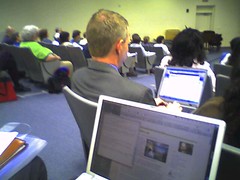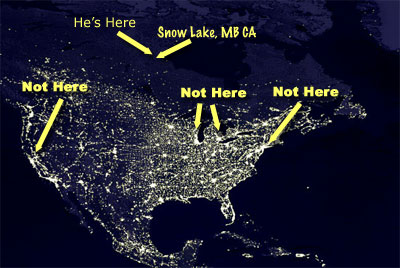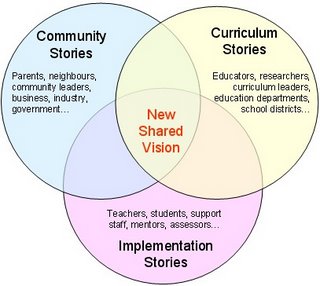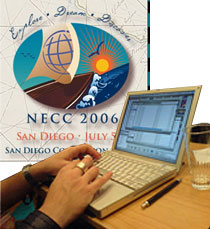I have had the opportunity, twice in the last several weeks, to talk about the new story of 21st century education in workshop settings. Because these experiences were conversations rather than presentations and because, in both instances, the audiences were self-selected tech-savvy and forward thinking professional educators, I had a unique chance to reflect on the topic. From these conversations, I realized that we need to refine the story, or at least the focus and message of our stories. So I’d like to take this opportunity to suggest some common focal points.
First of all, I would like to stick with Dr. Jennifer James’ components of the leader’s compelling new story:
- That the story must fit the marketplace and our sense of the future,
- That it must resonate with deeply held values, and
- That it must be something that we can model.
I also believe that our stories should be broken down into the three categories or three audiences that I talked about in “Types of New Stories“, and that Roger Stack, in Tasmania, refined last month (The New Story). But I’m going to let that part sit still for a while.
Marketplace
First of all, it seems to me that the foundation of the changes in our workplace, especially as described in the flat world conversations is globalization. It’s certainly not the only catalyst for change in the market place, but it is one that people know about, talk about, lament and even fear. It’s a story that is already being told and one that we can piggyback on to with messages of how education must adapt, not so much to make our students competitive, but to make them collaborative. To adapt in a global economy, they need to have global skills.
I can’t find the specific source, but Charles Darwin seems to have said that, “It is not the strongest of the species that survives, nor the most intelligent that survives. It is the one that is the most adaptable to change.”
Values
As far as our values are concerned, we all care about our children. We want them to be happy and prosperous, and we want them to have a fulfilling future. An untold value also points to our future, which rests, to no small degree on the prosperity of our children. But I think that a lot of our story must be about our children.
Marc Prensky is probably most focused on these stories if you have a chance to see him present at a conference. David Thornburg and others, including myself, also talk about the ways that our children are different from any generation before. They have more access to information and have more technology and skills in using that information than any generation before. They are almost totally focused on information and not merely the consumption of content. They want to play the information, to work it. They are producers of new content — mixers and remixers. We need to illuminate the incredible disconnect between our children’s world view and the classrooms that we sentence them to.
Modeling the Story
Finally, we need to be able to model the story. We need to be able to talk about our classrooms, where they are and where they should be. We need to be able to paint a clear and compelling picture that will drive people to want classrooms that work today. I think that shaping our stories around the image of flattening classrooms could serve us both in terms of aligning with an already told story, but also because it is a accurate and easily illustrated condition of today’s learning environments, perhaps even more universally accurate than that of a flat world.
From their perspective, as information users, students see themselves as being more literate, more connected, and more practiced information artisans than are their teachers. Teachers, curriculum, textbooks, and standards no longer rest on a hill or even a pedestal. The classroom is flat. There are stories that describe what the flat classroom looks like and how it could work.
So the focal points are:
| • Fitting the Market Place? |
— |
Globalization |
| • Resonating with deeply held values? |
— |
Our Children are different |
| • Modeling the story? |
— |
Flat classrooms |
I believe that it is critical that these three story points must have a common thread. Clearly, that is the sudden networking of our world. Thomas Friedman points to the Internet that we installed into various points around the world in order to help us prepare for Y2K, and how that network remained and began to flatten the world, accelerating globalization.
Our kids are connected in ways that would have been unimaginable to most teachers and grand parents, and many of their parents, and they are doing amazing things with that connectivity. Their are stories around their mobile phones, Internet-connected video games, and their experience in MySpace-style online communities.
Classrooms have become flat because our students are so connected, have so much access to information, and are so practiced at utilizing that information. The teachers, textbooks, and standards that they face in their classrooms seem irrelevant and small, compared to the content and media-rich experiences that they have outside the classroom.
This blog has gotten long enough and I fly to Florida today for a workshop tomorrow on blogging and podcasting. I look forward to your comments and to continuing this conversation.

 I wanted to double and triple check this before I blogged it, but it’s been confirmed from the very highest levels. NECC 2006, San Diego, will be wireless. All of the session rooms will be wireless with a hard wire Ethernet connection for presenters.
I wanted to double and triple check this before I blogged it, but it’s been confirmed from the very highest levels. NECC 2006, San Diego, will be wireless. All of the session rooms will be wireless with a hard wire Ethernet connection for presenters.
 Last night I attended the bi-monthly Raleigh Blogger Meetup in the WiFi rich
Last night I attended the bi-monthly Raleigh Blogger Meetup in the WiFi rich 
 One month from now, I’ll be at NECC. Certainly the richest and deepest educational technology conference, probably in the world, NECC offers more to more people about new technologies in education than any other event, and it proves each year to be exhaustingly exhilarating experience — almost a high.
One month from now, I’ll be at NECC. Certainly the richest and deepest educational technology conference, probably in the world, NECC offers more to more people about new technologies in education than any other event, and it proves each year to be exhaustingly exhilarating experience — almost a high.